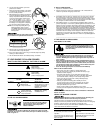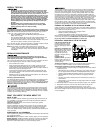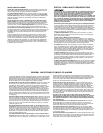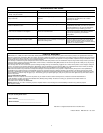
B
A
T
T
E
R
Y
S
E
R
V
I
C
E
SMOKE
CO
T
ES
T
S
IL
E
N
C
E
M
O
V
E
T
O
F
R
E
S
H
A
IR
Model SC01N
Printed in Mexico
M08-0015-001 Q 07/04
IMPORTANT!
PLEASE READ CAREFULLY AND SAVE.
This user’s manual contains important information about your Smoke/CO
Alarm’s operation. If you are installing this Smoke/CO Alarm for use by
others, you must leave this manual—or a copy of it—with the end user.
TABLE OF CONTENTS
Introduction . . . . . . . . . . . . . . . . . . . . . . . . . . . . . . . . . . . . . . . . . . . . . . . . .1
Fire Safety Tips . . . . . . . . . . . . . . . . . . . . . . . . . . . . . . . . . . . . . . . . . . .1
Basic Safety Information . . . . . . . . . . . . . . . . . . . . . . . . . . . . . . . . . . . .1
Installation . . . . . . . . . . . . . . . . . . . . . . . . . . . . . . . . . . . . . . . . . . . . . . . .2-3
Where to Install This Alarm . . . . . . . . . . . . . . . . . . . . . . . . . . . . . . . . . .2
Where This Alarm Should NOT Be Installed . . . . . . . . . . . . . . . . . . . . .2
How to Install This Alarm . . . . . . . . . . . . . . . . . . . . . . . . . . . . . . . . . .2-3
If Your Smoke/CO Alarm Sounds . . . . . . . . . . . . . . . . . . . . . . . . . . . . . . . .3
What To Do First–Identify The Type Of Alarm . . . . . . . . . . . . . . . . . . . .3
If the CO Alarm Sounds . . . . . . . . . . . . . . . . . . . . . . . . . . . . . . . . . . . .3
If the Smoke Alarm Sounds . . . . . . . . . . . . . . . . . . . . . . . . . . . . . . . . .3
Using the Silence Feature . . . . . . . . . . . . . . . . . . . . . . . . . . . . . . . . . . .4
Weekly Testing . . . . . . . . . . . . . . . . . . . . . . . . . . . . . . . . . . . . . . . . . . . . . . .4
Regular Maintenance . . . . . . . . . . . . . . . . . . . . . . . . . . . . . . . . . . . . . . . . . .4
What You Need To Know About CO . . . . . . . . . . . . . . . . . . . . . . . . . . . . . .4
What is CO? . . . . . . . . . . . . . . . . . . . . . . . . . . . . . . . . . . . . . . . . . . . . .4
Symptoms of CO Poisoning . . . . . . . . . . . . . . . . . . . . . . . . . . . . . . . . .4
Potential Sources of CO in the Home . . . . . . . . . . . . . . . . . . . . . . . . . .4
How Can I Protect My Family From CO Poisoning? . . . . . . . . . . . . . . . . .5
Regulatory Information For Smoke/CO Alarms . . . . . . . . . . . . . . . . . . . . .5
Regulatory Information for CO Alarms . . . . . . . . . . . . . . . . . . . . . . . . . .5
Regulatory Information for Smoke Alarms . . . . . . . . . . . . . . . . . . . . . . .5
Recommended Locations for Smoke Alarms . . . . . . . . . . . . . . . . . . . .5
About Smoke Alarms . . . . . . . . . . . . . . . . . . . . . . . . . . . . . . . . . . . . . .6
Special Compliance Considerations . . . . . . . . . . . . . . . . . . . . . . . . . . . . .6
General Limitations Of Smoke/CO Alarms . . . . . . . . . . . . . . . . . . . . . . . .6
Troubleshooting Guide . . . . . . . . . . . . . . . . . . . . . . . . . . . . . . . . . . . . . . . .7
Limited Warranty . . . . . . . . . . . . . . . . . . . . . . . . . . . . . . . . . . . . . . . . . . . .7
All Rights Reserved. © 2004 BRK Brands, Inc.
BRK Brands, Inc., 3901 Liberty Street Road, Aurora, IL 60504-8122
Consumer Affairs: (800) 323-9005 • www.firstalert.com
1
USER’S MANUAL
SMOKE AND CARBON MONOXIDE ALARM
Features:
• Separate sensors to detect smoke
and CO. The two alarm systems
work independently.
• Powered by a single 9V alkaline or
lithium battery
• Flip-open battery door for easy
battery replacement
• Large, easy-to-use Test button
• Colored lights indicate “battery
status” and “service needed.”
All First Alert
®
Smoke Alarms conform to regulatory requirements,
including UL217 and are designed to detect particles of combustion.
Smoke particles of varying number and size are produced in all fires.
Ionization technology is generally more sensitive than photoelectric
technology at detecting small particles, which tend to be produced
in greater amounts by flaming fires, which consume combustible
materials rapidly and spread quickly. Sources of these fires may include
paper burning in a wastebasket, or a grease fire in the kitchen.
Photoelectric technology is generally more sensitive than ionization
technology at detecting large particles, which tend to be produced in
greater amounts by smoldering fires, which may smolder for hours
before bursting into flame. Sources of these fires may include cigarettes
burning in couches or bedding.
For maximum protection, use both types of Smoke Alarms on each
level and in every bedroom of your home.
INTRODUCTION
FIRE SAFETY TIPS
Follow safety rules and prevent hazardous situations: 1) Use smoking materi-
als properly. Never smoke in bed. 2) Keep matches or lighters away from chil-
dren; 3) Store flammable materials in proper containers;
4) Keep electrical appliances in good condition and don’t overload electrical
circuits; 5) Keep stoves, barbecue grills, fireplaces and chimneys grease- and
debris-free; 6) Never leave anything cooking on the stove unattended; 7) Keep
portable heaters and open flames, like candles, away from flammable materi-
als; 8) Don’t let rubbish accumulate.
Keep alarms clean, and test them weekly. Replace alarms immediately if they
are not working properly. Smoke Alarms that do not work cannot alert you to a
fire. Keep at least one working fire extinguisher on every floor, and an addition-
al one in the kitchen. Have fire escape ladders or other reliable means of
escape from an upper floor in case stairs are blocked.
BASIC SAFETY INFORMATION
• Dangers, Warnings, and Cautions alert you to important
operating instructions or to potentially hazardous situations.
Pay special attention to these items.
• This Smoke/CO Alarm is approved for use in single-family
residences. It is NOT designed for marine or RV use.
•
This combination Smoke/Carbon Monoxide Alarm has two separate
alarms. The CO Alarm is not designed to detect fire or any other gas.
It will only indicate the presence of carbon monoxide gas at the sen-
sor. Carbon monoxide gas may be present in other areas. The Smoke
Alarm will only indicate the presence of smoke that reaches the sen-
sor. The Smoke Alarm is not designed to sense gas, heat or flames.
•
This Smoke/CO Alarm cannot operate without a working battery.
Removing the battery for any reason, or failing to replace the battery
at the end of its service life, removes your protection.
•
NEVER ignore any alarm. See “If Your Smoke/CO Alarm Sounds” for
more information on how to respond to an alarm. Failure to respond
can result in injury or death.
• The Silence Feature is for your convenience only and will not cor-
rect a Smoke/CO problem. Always check your home for a potential
problem after any alarm. Failure to do so can result in injury or
death.
•
Test this Smoke/CO Alarm once a week. If the Alarm ever fails to test
correctly, have it replaced immediately! If the Alarm is not working
properly, it cannot alert you to a problem.
• This product is intended for use in ordinary indoor locations of
family living units. It is not designed to measure CO levels in
compliance with Occupational Safety and Health Administration
(OSHA) commercial or industrial standards. Individuals with
medical conditions that may make them more sensitive to carbon
monoxide may consider using warning devices which provide audi-
ble and visual signals for carbon monoxide concentrations under
30 ppm. For additional information on carbon monoxide and your
medical condition contact your physician.









